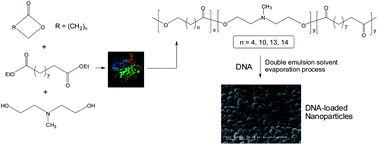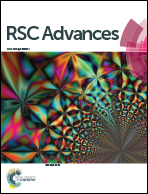Exploring the solid state properties of enzymatic poly(amine-co-ester) terpolymers to expand their applications in gene transfection†
Abstract
Polymers bearing amino functional groups are an important class of materials capable of serving as non-viral carriers for DNA delivery to living cells. In this work biodegradable poly(amine-co-ester) terpolymers were synthesized via ring-opening and polycondensation copolymerization of lactone (ε-caprolactone (CL), ω-dodecalactone, ω-pentadecalactone (PDL), and ω-hexadecalactone) with diethyl sebacate (DES) and N-methyldiethanolamine (MDEA) in diphenyl ether, catalyzed by Candida antarctica lipase B (CALB). All lactone-DES-MDEA terpolymers had random distributions of lactone, sebacate, MDEA repeat units in the polymer chains. PDL-DES-MDEA terpolymers were studied in the composition range from 21 to 90 mol% PDL whereas the terpolymers with other lactones were investigated at a single composition (80 mol% lactone). DSC and WAXS analyses showed that all investigated terpolymers crystallize in their respective homopolylactone crystal lattice. Terpolymers with large lactones and a high lactone content melt well above room temperature and are hard solids, whereas terpolymers with small lactones (e.g. CL) or with a low lactone content melt below/around ambient temperature and are waxy/gluey materials. Given the importance of hydrophobicity in influencing gene delivery, water contact angle measurements were carried out on lactone-DES-MDEA terpolymers showing that it is possible to tune the hydrophilic-to-hydrophobic balance by varying polymer composition and size of lactone units. To demonstrate the feasibility of using solid terpolymers as nanocarriers for DNA delivery, PDL-DES-MDEA copolymers with 65–90% PDL were successfully transformed into free-standing nanoparticles with average particle size ranging from 163 to 175 nm. Our preliminary results showed that LucDNA-loaded nanoparticles of the terpolymer with 65% PDL were effective for luciferase gene transfection of HEK293 cells.


 Please wait while we load your content...
Please wait while we load your content...